A specialty of Hokkaido, Japan, Butadon is a rice bowl dish topped with grilled pork slices and caramelized soy sauce. The sweet and savory flavor is a major win! Easy to make and ready in 15 minutes.
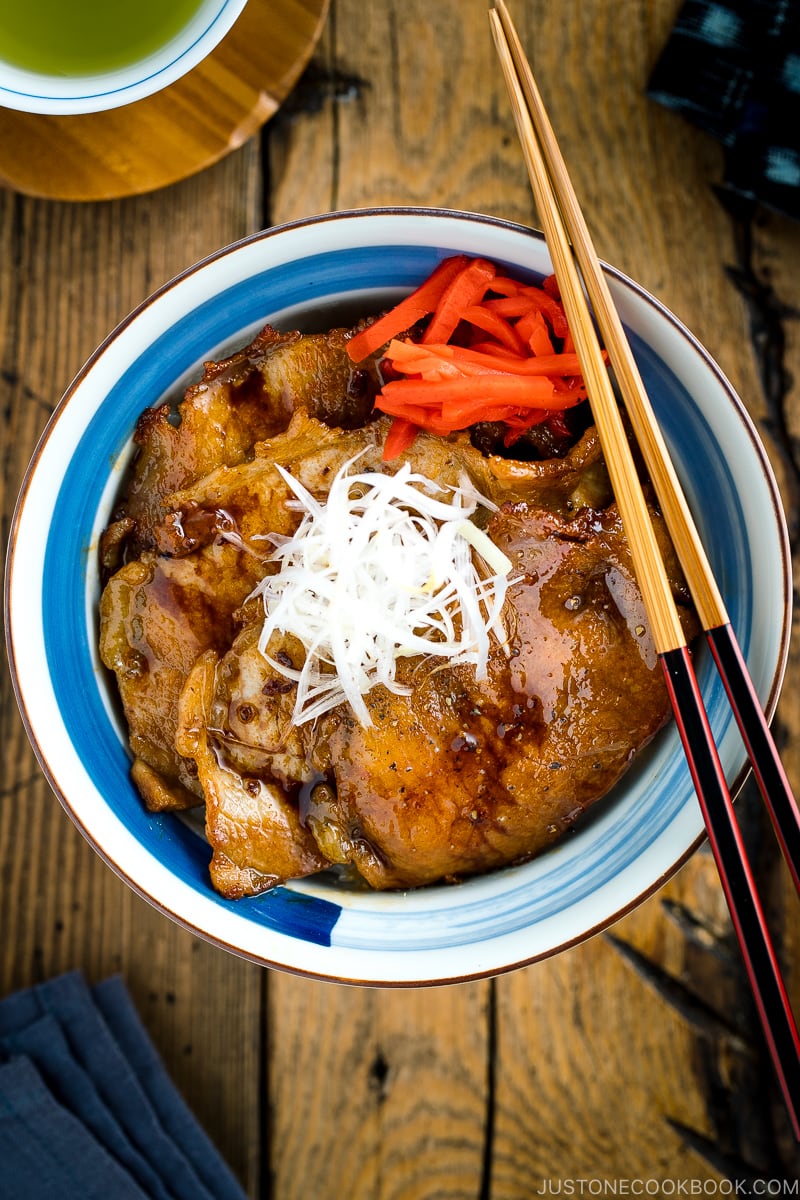
Like many home cooks, I often rely on quick and budget-friendly dinners that actually taste delicious. And this Butadon (豚丼) or Pork Bowl couldn’t be easier.
It is one of the many donburi (rice bowls) that I enjoy making when I am reluctant to cook a full spread Japanese meal. Partner the rice bowl with miso soup and a simple salad or meal prep sides, you’d get a complete and nutritious dinner!
Table of Contents
What is Butadon?
Hailed from Tokachi (十勝) region in Hokkaido, Butadon is a popular specialty food that you want to check out when you visit the northern island of Japan.
Topped with grilled thin-sliced pork, the rice bowl is true comfort food at its best! The dish is all about the quality of pork (known in Tokachi region) and rice grown in Hokkaido, and delicious sweet and savory “tare” sauce.
The thin pork loin slices are grilled (over binchotan charcoal) till tender, and dipped in or brushed with the sauce layer after layer. They are then served over fluffy steamed rice with a generous helping of sauce drizzled over the meat for one last time.
The juicy meat, amazing sauce and hot steamy rice will make you craving for more.
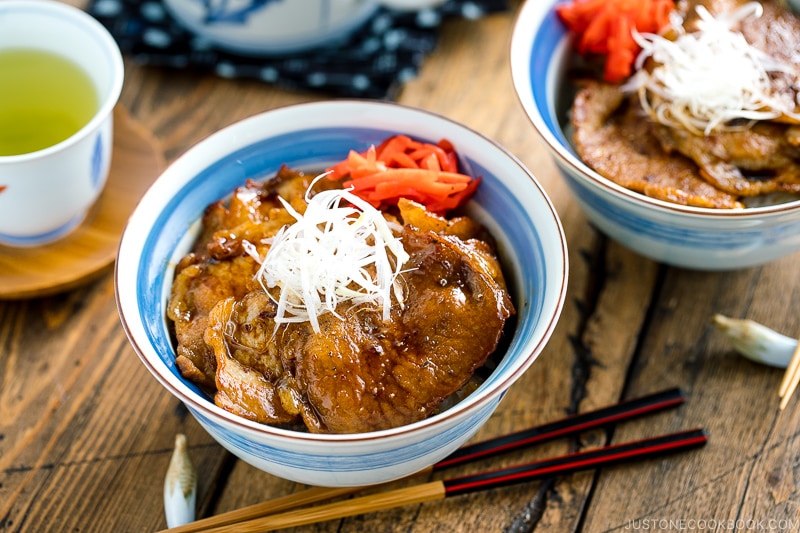
The Ingredients You’ll Need for Butadon
1. Thinly Sliced Pork Loins
You can get these thinly sliced pork loins from a Japanese, Korean, or Chinese grocery store. It is a popular cut in our cuisines and is often used for hot pots and stir-fries.
In the refrigerator section of the Japanese market, there are typically 2 kinds. Paper-thin slices for “Shabu Shabu” or medium-thin slices for “Shoga Yaki” or “Ginger Pork”. For the Butadon recipe, you’d want to go with the medium-thin slices.
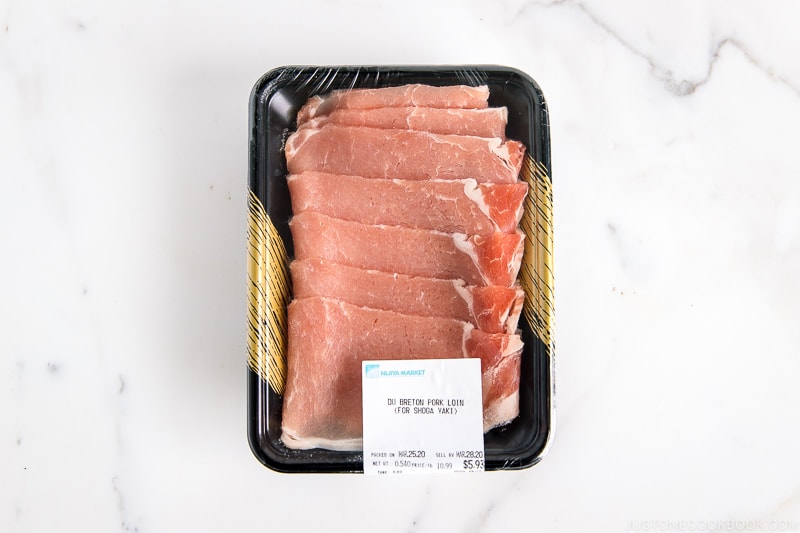
Substitute: If you don’t eat pork, you can use chicken, beef, fish, shrimp, firm tofu, zucchini, eggplant, or king oyster mushrooms. If you can’t get thinly-sliced pork, you can put the pork loin in the freezer for one hour (or more) until firm on the outside and slice it thinly (see my tutorial here).
2. Japanese Short-Grain Rice
When you make Japanese donburi or rice bowl dishes, I recommend using Japanese short-grain rice. The steamed rice stick to each other and is not in loose form, so you can pick up small chunks of steamed rice, and thin-sliced pork, and garnish all with chopsticks.
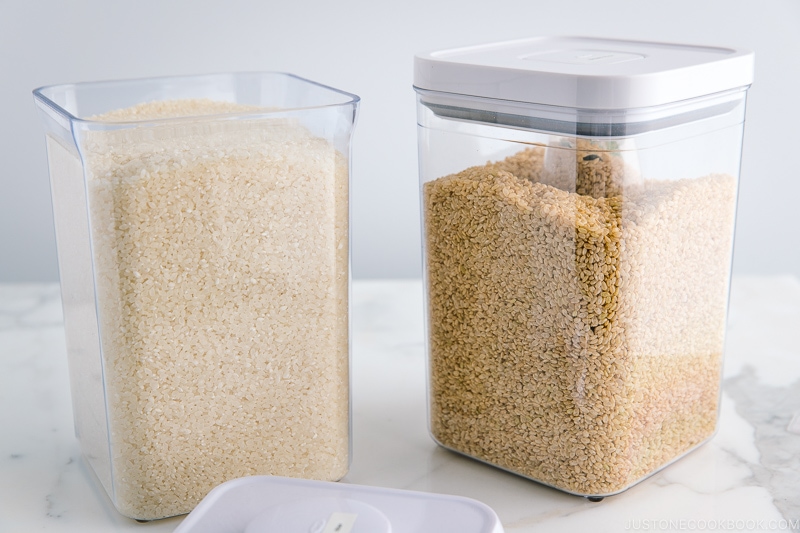
Substitute: Korean brands of short-grain rice are similar to Japanese short-grain rice. If you plan to make more Japanese dishes, I highly recommend getting short-grain rice. Here’s more about Japanese short-grain rice.
3. Simple “Tare” Sauce
To make the delicious sauce, you would need just three simple ingredients: sugar, soy sauce, and sake. I really like how simple it is. Instead of mixing all the ingredients, we actually make the caramel sauce first, then add soy sauce and sake.
When the sugar turns darker in color and tastes nuttier with a slightly bitter note, it adds another layer of complexity to the sauce.
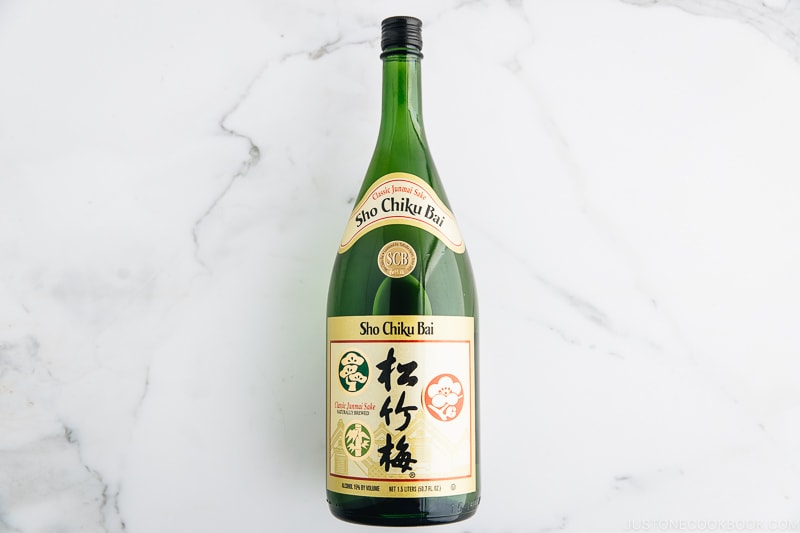
I use regular drinking sake in all my recipes. This Sho Chiku Bai is for drinking, just a bit less expensive than what we would normally choose for drinking. For this big bottle, it only costs us $10 or so at an Asian grocery store or Japanese supermarket.
Substitute: You can use Chinese rice wine or dry sherry if you can’t find sake. There are other brands that I mentioned on my Sake Pantry Page.
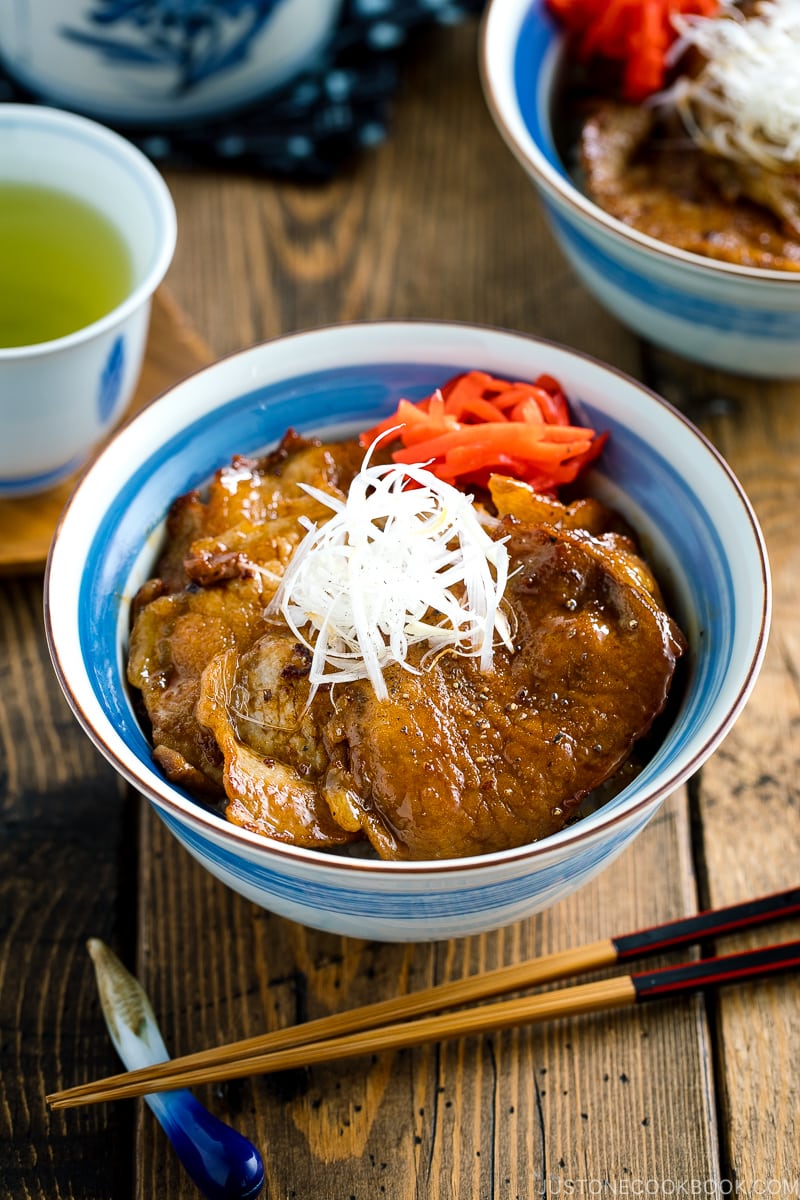
3 Butadon Cooking Tips
- Make several slits for the meat. Make several slits on the connective tissue between the meat and fat. The reason why you do this is that red meat and fat have different elasticity, and when they are cooked they will shrink and expand at different rates. This will allow the meat to stay nice and flat and prevent it from curling up.
- Make caramel for the sauce. Read the tips on how to make caramel below and in the recipe. Read the instructions first, as you need to pay full attention to the process once you start.
- Thicken the sauce (optional). If you like your sauce to be thicker, you can coat your pork slices with potato starch or flour (all-purpose flour would do) before pan-frying. Pan-fry the same way, following my recipe. This extra coating will thicken the sauce as you pour it into the pan. Lower the heat and quickly coat the meat with the sauce.
3 Caramel Making Tips
- Use a heavy bottom pot. The heavy bottom pot helps cook the sugar evenly. Make sure the pot is big/tall since the caramel will bubble quite a bit once the boiling water is added. Non-stick or coated pans are not recommended because the sugar can pull the coating off the pan.
- Add boiling water to stop caramelization. To stop the caramel from cooking further, add boiling water. Why boiling water? As the boiling water temperature is close to the caramel, it splutters less. This should be done very carefully, as the liquid will hiss and sputter. This brings us to the next tip.
- Protect your fingers from splatters. While you’re making caramel sauce, you’re required to pour boiling water. It’s so important to protect your fingers and face from splatters. When you pour boiling water, protect your hand that you’re pouring water with a kitchen glove. Hold a lid with the other hand to minimize the splatter.
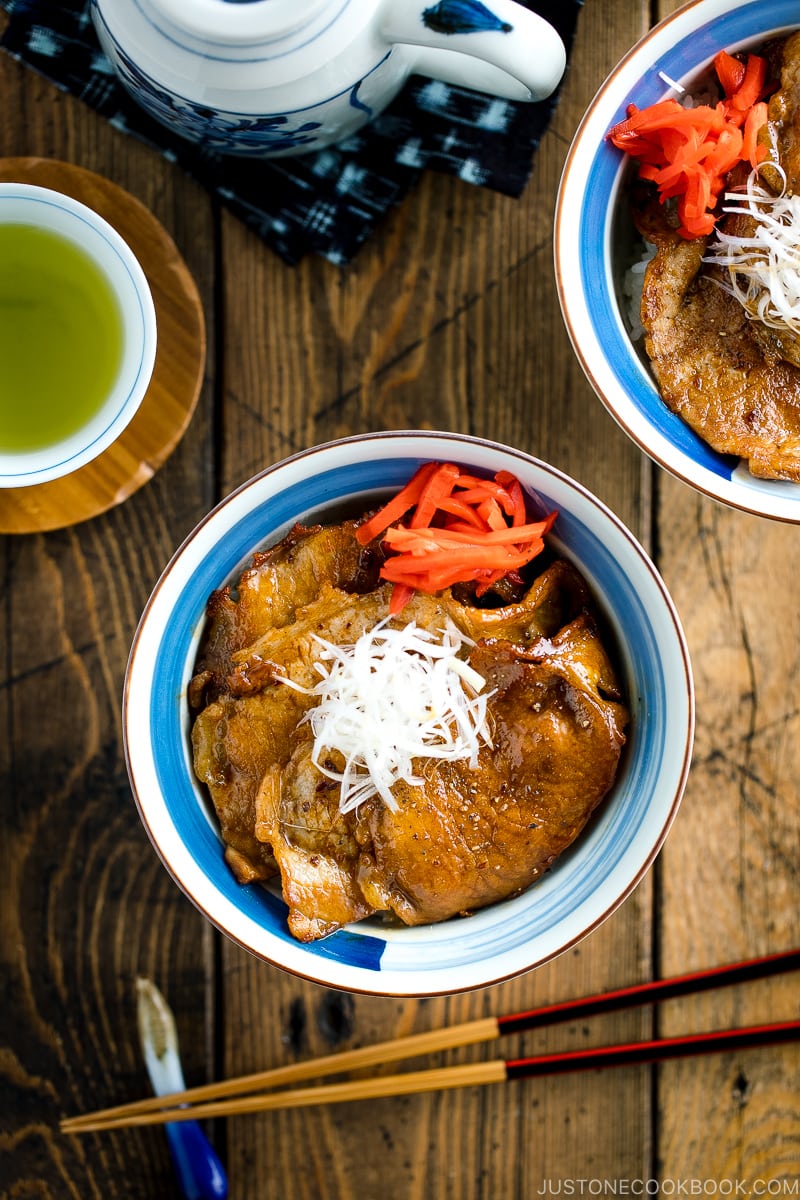
What to Serve with Butadon
Serve the Butadon with miso soup and small sides of vegetables that you can make in advance. Here are some of my recommendations.
- Vegetable Miso Soup
- Kinpira Renkon
- Simmered Fried Tofu and Greens
- Spinach Ohitashi
- Broccoli Blanched with Sesame Oil
More Delicious Rice Bowl Recipes You’ll Love
- Soboro Don (Ground Chicken Bowl)
- Vegan Poke Bowl
- Yoshinoya Beef Bowl (Gyudon)
- Oyakodon (Chicken and Egg Bowl)
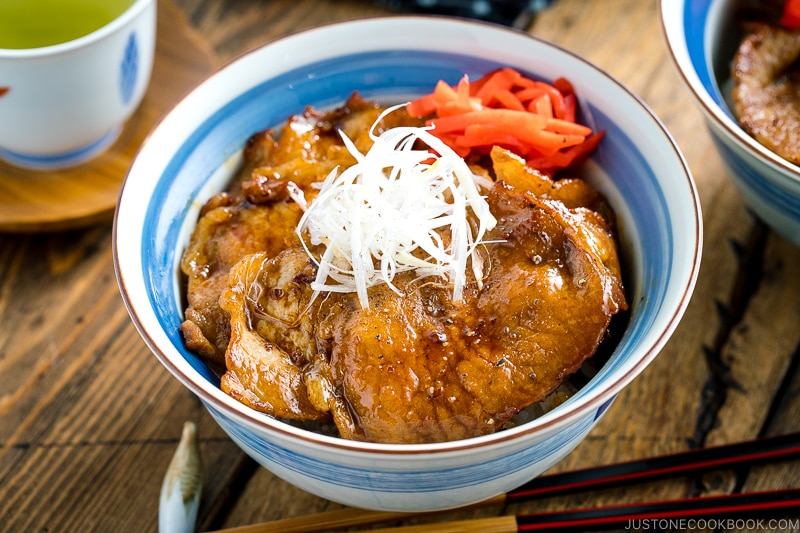
Wish to learn more about Japanese cooking? Sign up for our free newsletter to receive cooking tips & recipe updates! And stay in touch with me on Facebook, Pinterest, YouTube, and Instagram.
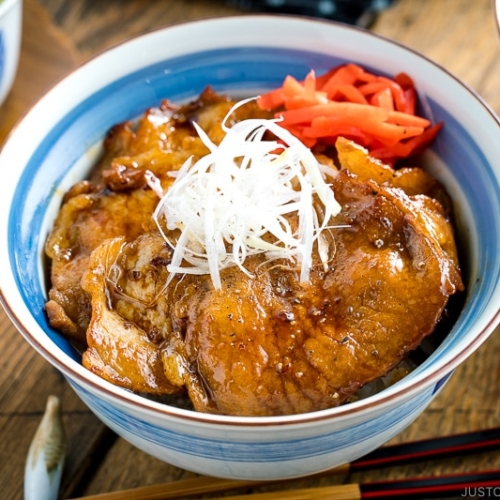
Butadon (Pork Donburi)
Ingredients
For the Sauce
For the Pork
- ½ lb thinly sliced pork loin (labeled “for ginger pork/shogayaki“ at the Japanese market; or follow my tutorial to thinly slice meat at home)
- 1 Tbsp neutral oil
- 2 servings cooked Japanese short-grain rice (typically 1⅔ cups (250 g) per donburi serving)
For the Garnish
- freshly ground black pepper
- 4 inches Tokyo negi (naga negi; long green onion) (use only the white part; or substitute chopped scallions)
- pickled red ginger (beni shoga or kizami beni shoga) (optional; you can make Beni Shoga at home)
Instructions
Before You Start…
- For the steamed rice, please note that 1½ cups (300 g, 2 rice cooker cups) of uncooked Japanese short-grain rice yield 4⅓ cups (660 g) of cooked rice, enough for 2 donburi servings (3⅓ cups, 500 g). See how to cook short-grain rice with a rice cooker, pot over the stove, Instant Pot, or donabe.
- Gather all the ingredients. Make sure 4 Tbsp boiling water is ready before you start.

To Make the Sauce
- In a heavy-bottom, high-sided saucepan, combine 3 Tbsp sugar and 1 Tbsp water. Turn the burner on medium heat. Cook, stirring at the beginning with a wooden spoon or silicone spatula, until the sugar dissolves. Once the sugar dissolves and the mixture begins to bubble, stop stirring. Let the sugar and water cook together. As the water evaporates and the sugar temperature rises, the sugar will begin to caramelize. You can gently swirl the pan to achieve even caramelization. Watch the pan closely, as this process moves quickly. In the meantime, prepare the boiling water and have it ready to use when the caramelized sugar is done.

- When your caramelized sugar reaches an amber color, turn off the heat. Add 4 Tbsp boiling water with one hand (wear a kitchen mitt to protect your hand) and hold a lid with the other hand to protect yourself from splattering as you pour the boiling water. Once the splatter stops, turn the stove back on and mix well. If there is crystallized sugar, it will melt again.

- Add 3 Tbsp soy sauce and 2 Tbsp sake and bring it to simmer, then turn off the heat.

To Prepare the Negi and Pork
- If you can get Tokyo negi (long green onion) from a Japanese grocery store, you can garnish the donburi with shiraga negi. Cut 4 inches Tokyo negi (naga negi; long green onion) and make an incision lengthwise to remove the green core. We only use the white outer layers. With a sharp knife, cut the white layers into julienned pieces. Soak them in water both to get rid of the bitterness and curl up the julienned pieces.

- With ½ lb thinly sliced pork loin, make several slits on the connective tissue between the meat and fat, which have different elasticities and will shrink and expand at different rates when cooked. Cutting these slits allows the meat to stay flat and prevents it from curling.

To Cook the Butadon
- Heat a large frying pan over medium to medium-high heat. When it‘s hot, add 1 Tbsp neutral oil to heat. Then, add some of the pork slices in a single layer. Sear the pork in batches and don‘t overcrowd the pan.

- Sear the bottom side until nicely browned, then flip over to sear the other side. When the other side is brown, remove the meat to a plate. Here, you only need to sear the meat. DO NOT overcook it, as you will pan-fry it again in the sauce later.

- Add the new slices of pork to sear another batch.

- Once all the meat is seared, return the meat to the pan. Pour most of the sauce in the pan, reserving some for drizzling over the steamed rice and the meat.

- Coat both sides of the meat with the sauce.

To Serve
- Divide 2 servings cooked Japanese short-grain rice into individual donburi (large) bowls. Drizzle some reserved sauce on the rice. Place the meat on top, layering the slices.

- Drizzle more sauce on the meat, if you‘d like. Season with freshly ground black pepper on top.

- Garnish with shiraga negi and pickled red ginger (beni shoga or kizami beni shoga). Serve immediately.

To Store
- You can store the grilled pork loin in an airtight container and keep in the refrigerator for up to 2–3 days or in the freezer for up to a month.
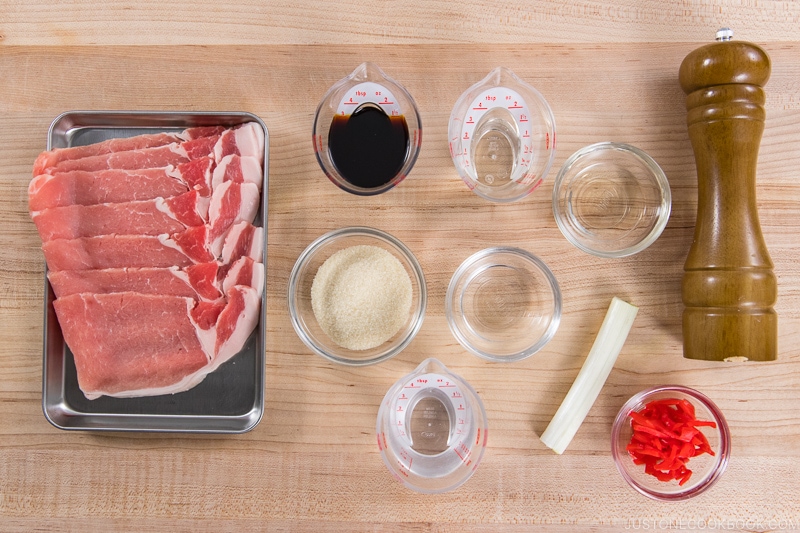
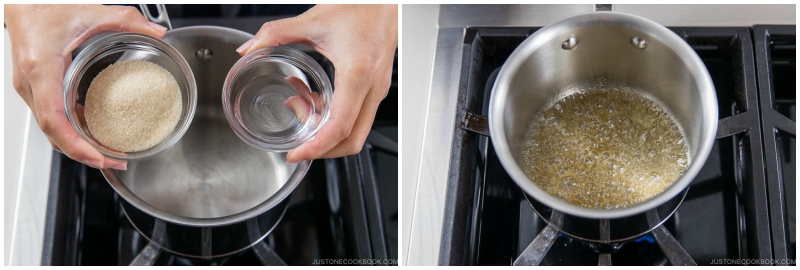
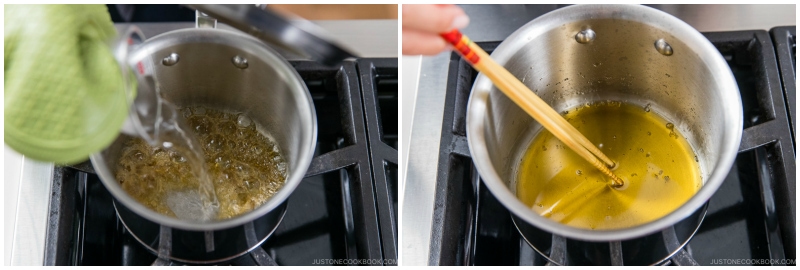
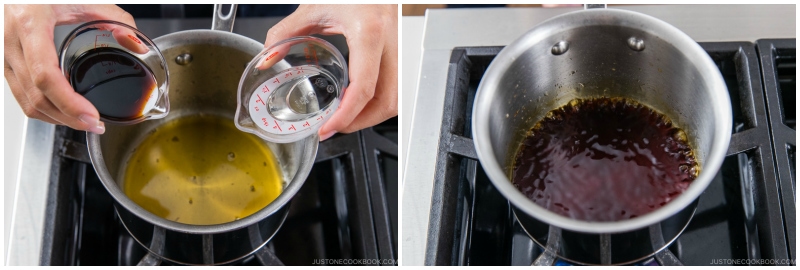
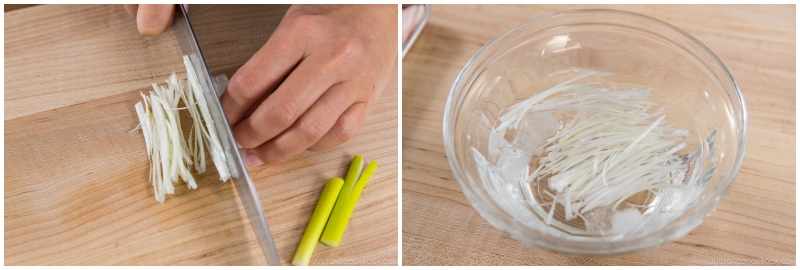
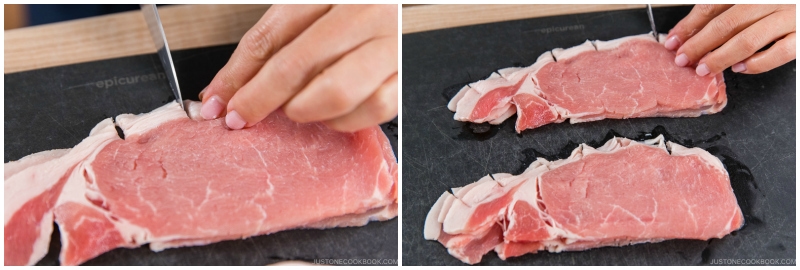
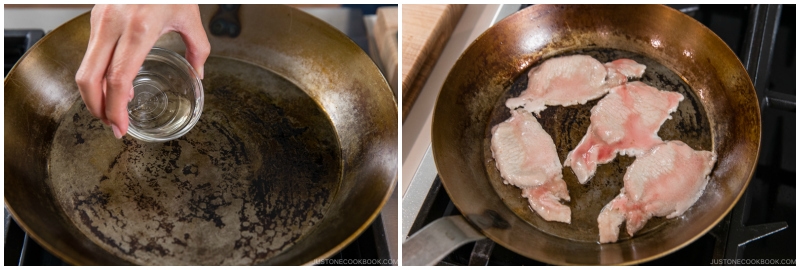
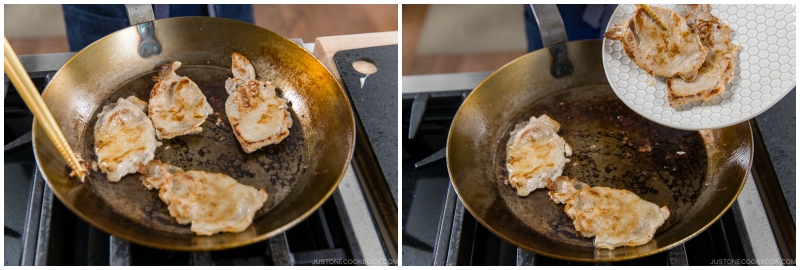
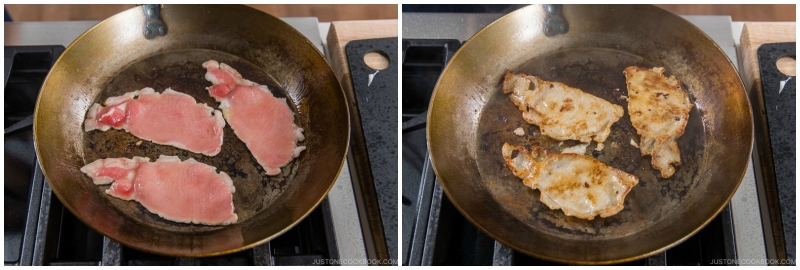
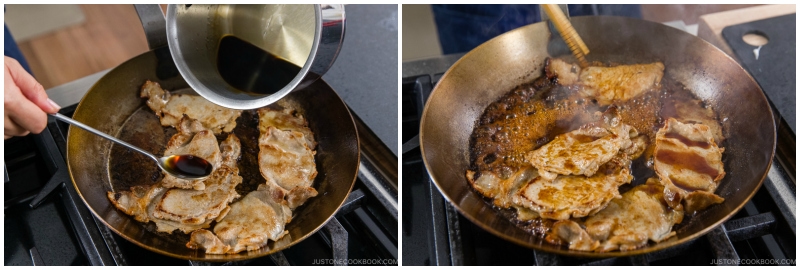

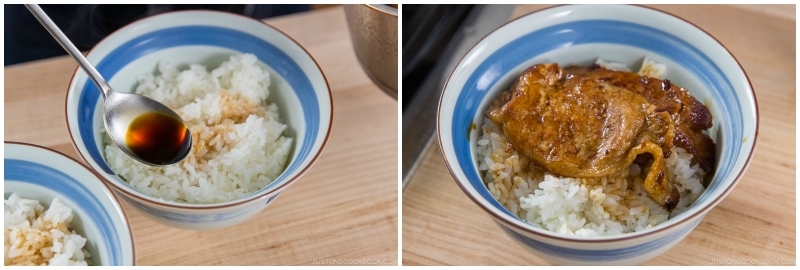
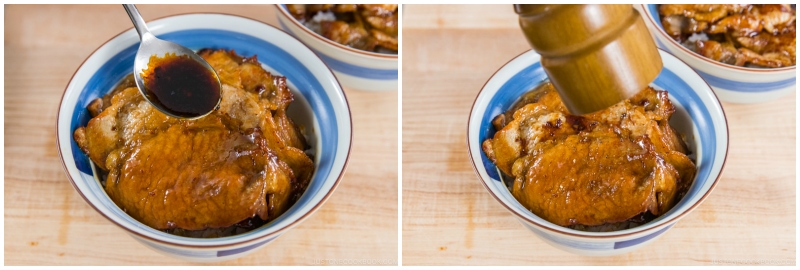
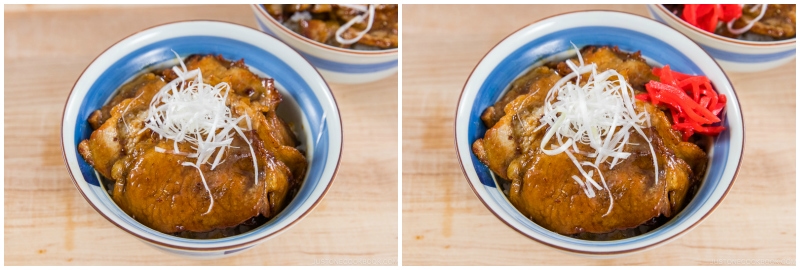










Made this today and it was delicious! While waiting for the sugar to caramelize I fried a bit of onion and oyster mushrooms which were a nice addition. My store only had shabushabu pork, but it was perfect! Very fast to cook and good marbling.
I think next time I may reduce the sugar (it is carmalized sweet sugar after all!) but all in all a great recipe. Thank you!
Hi Kay! We are glad to hear you enjoyed Nami’s recipe!
Yes! Please feel free to adjust the sugar amount to your liking and keep the recipe.☺️ Happy Cooking!
First for caramalising sugar lol but it went well and food was great, thank you 🙏🏼
Hi Paula! Thank you very much for trying Nami’s recipe and for your feedback!
We are glad to hear you enjoyed the Butadon!
Very good indeed. So yummy and easy to cook. My children love it.
Hi Sagitt73, We are glad to hear your children love this Butadon! Thank you very much for trying this recipe and for your kind feedback!
Gaikokujin question here. Haha. I notice the pork is not sliced into bite-size pieces before serving like many meat dishes are in Japanese cuisine. Do we just pick up the pork slices with chopsticks and bite off a piece? I guess it is easy enough since it is sliced thin?
Thank you for your help. 🙂
Hi Lion,
We usually cut large pieces into bite-sized pieces before carrying them to the mouth, and this pork is thinly sliced pork and thin enough to cut with chopsticks.
However, if you think it will be difficult for you to enjoy it, please feel free to cut it into smaller pieces before you serve it.
We hope this helps.🙂
Delicious and simple. Loved it. Thanks for sharing
Hi Terry! I’m so happy to hear that you enjoyed this recipe. Thank you for your kind feedback. 🙂
This was easy once I tried to make and my husband couldn’t eat enough! Plus my 2 picky eaters enjoyed! Fantastic recipe!
Hi Samantha! I’m so happy to hear your family enjoyed this recipe. Thank you for your kind feedback! 🙂
I tried the recipe tonight. It is very easy to overcook the pork slices! My sauce was also runny….I will try again later this week! The recipe seems quite simple but requires some skills!
Hi Maggie! Thanks for trying this recipe! My sauce is runny too. You can thinly coat the pork with potato starch or flour so that the sauce will thicken when it’s added to the pan. That’s one option if you want to thicken the sauce. 🙂
Btw, I have made extra sauce, what can I make with it and how long can I keep it?
You can use it for meat, veggies, tofu, mushrooms… anything, but make sure to add the sauce after the grill because it gets burnt easily.
Thank you very much for sharing this recipe! The taste is very nice but the pork loin that I used maybe have no fat, so it comes out quite hard to bite. Will try again next time. Thanks again.
Hi Yap! Yeah you’ll need some fat in the pork loin so it is not too tough. But overcooking is a big issue for toughness. If you look at the famous Butadon shops (https://www.jalan.net/news/article/382402/), you will see their meat is either loin or bork belly. Pork belly can be quite fatty (lots of oil will come out), but if that’s something you enjoy, you can definitely use that. 🙂
can I use pork tendrrloin sliced medium thick to make the Butadon?
Hi Leslie! Pork loin is similar to pork tenderloin, but additional fat may render it a bit “meatier” and less tough texture… tenderloin is extra lean, so it requires certain coking to make it tender. For this quick pan-fry, it may not work as well. 🙂
Hi Nami, I have been an avid follower of your blog and when I saw this new recipe, I knew I had to make it this very weekend. My husband and I enjoyed butadon in Hokkaido last year and we were excited to try this homemade version. The instructions were easy to follow – thank you for writing such a thoughtful recipe! I might have overcooked the meat a little (I found it hard to sear such thin pieces of meat) but the sauce made everything so good. Brought back good memories 🙂
Hi Dani! Thank you so much for trying this recipe! You got to enjoy the real Butadon in Hokkaido! You know the meat is so different in Hokkaido… you’re so lucky! I agree, with pork loin, it’s hard as it doesn’t have much fat. Pork belly is too fatty… but these are the two meat used for Butadon. I think the quality of pork, in general, is really good in Japan, and it’s so hard to replicate the tenderness! Nevertheless, thanks for trying my recipe!
I made the butadon yesterday. It is very tasty and I will be making it again. I really enjoyed the combination of the sauce and the onion and ginger.
Thanks again for the great recipes.
Hi Barabara! So happy to hear you enjoyed this recipe! Thank you for your kind feedback! 🙂
Hi Nagi, could I use thinly sliced pork belly for the meat cut? I think it might taste more fattier so should I use another ingredient in the sauce to cut through that?
Hi Sally, Thank you very much for trying Nami’s recipe!
If you would like, you can add slice onion or cabbage when you cook meat.
We hope this helps!
Arigato, Alisa
Do itashi mashite, Alisa! 🙂
I especially love how simple the ingredients are and how fast the meal comes together!
I just found a couple bottles of sake hiding at the back of the cabinet. You bet I’ll be making more of your recipes now. 😊
Hi Elie! Awesome! Sake is like soy sauce in Japanese recipes. You’ll be using it a lot. Have fun cooking! Thank you for trying my recipe!